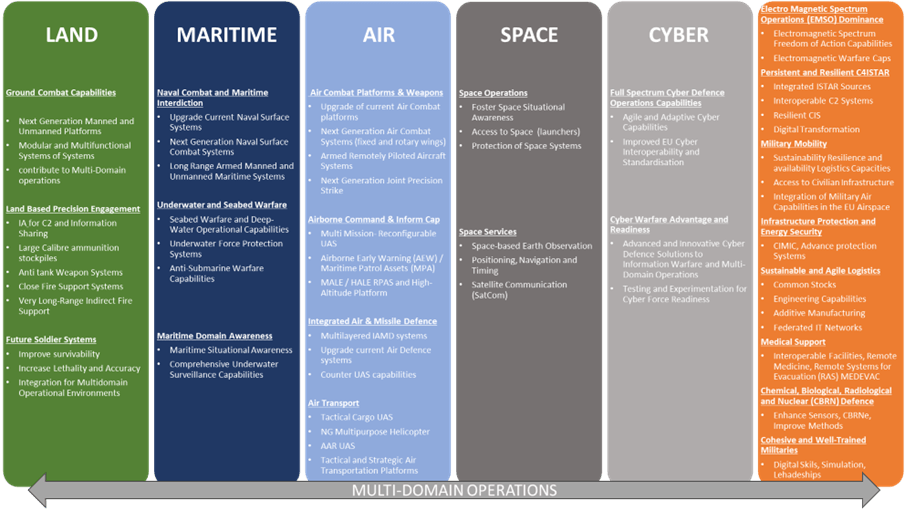Being prepared. Review of European Defense Priorities

In November, the European Defence Agency (EDA) published two documents providing insight into European military capabilities for the coming years.
The first of these is the document “Enhancing EU Military Capabilities Beyond 2040.” This document identifies the main trends that will shape military capabilities and technological advances in the defense sector over the next 20 years.
The EDA’s analysis identifies six global factors that will influence the future strategic environment, such as the effects of climate change that could bring water and resource scarcity, demographic changes resulting from migration, international complexity, and the impact of supply chains on the economy, shifts in global power, the new security environment where hybrid conflicts are increasingly common, and the ongoing digitization of society, which brings new risks and threats, including the growing use of social engineering and misinformation.
Emerging disruptive technologies (EDT) will play a key role in shaping military needs and capabilities beyond 2040. This analysis examines nine EDTs from the standpoint of capability development, describing possible military applications and challenges to consider as part of the future battlefield.
Among them, autonomous systems are a valuable example in this regard as they are rapidly being incorporated into military capabilities and are expected to accelerate in the coming years. Novel disruptive weapons, such as hypersonic and directed energy weapons, will bring new opportunities and challenges for armed forces.
Furthermore, artificial intelligence, the Internet of Things, biotechnology and human performance enhancement, advanced materials and additive manufacturing, blockchain, quantum technologies, and new space technologies will have a significant impact on future military capabilities.
Regarding military capabilities, multidomain connectivity, cognitive superiority that enables near-real-time situational awareness, the ability to deploy and manage energy from a variety of sources; the ability to counter future weapon systems, and increased dependence on space-based assets are expected to be dominant trends in the future.
All of this analysis was considered in the review of the EU’s priority capabilities, which are outlined in the recently revised document “The 2023 EU Capability Development Priorities (CDP),” approved by the Member States in November 2023.
The CDP is a comprehensive planning tool that provides an overview of European military capabilities over time. This document identifies EU defense priorities and opportunities for cooperation between Member States.
The review of the CDP at this time reflects changes in the EU’s strategic environment, the policy guidance provided by the Strategic Compass approved in 2022, and lessons learned from the war in Ukraine. In its development, existing shortcomings in the context of the Common Security and Defence Policy, lessons learned from recent operations and missions, and planned cooperation were taken into account. Long-term technological perspectives and future operational environments are also considered, with this aspect being touched on previously.
The result is a set of 22 priorities that, in addition to reasserting priorities from previous years, includes new ones derived from the profound change in the EU’s strategic environment. It reflects where efforts need to continue in certain areas (e.g., cyber defense, access to space, electromagnetic spectrum dominance, unmanned systems, and precision ground combat) and where previously identified shortcomings have been mitigated (e.g., in-flight refueling and the fight against improvised explosive devices).
Work will be done on these priorities in the coming years through several EU defense initiatives and tools, such as the Coordinated Annual Review on Defence (CARD), Permanent Structured Cooperation (PESCO), and the European Defence Fund (EDF). They will also guide research and innovation activities in the defense field, shaping the research agenda and engagement with industry.
It will therefore be necessary, both at the level of industry and from the Member States, to engage deeply in collaboration and innovation, in addition to the willingness to adopt new technologies.
GMV is a leader in the development of systems directly related to some of the CDP priorities, such as using AI for command and control systems and unmanned UxS systems, navigation, and ISTAR, among others.
At GMV, we will continue to innovate and participate in European collaboration projects, both in the EDF and in other areas, that enable us to develop the capabilities necessary for our armed forces in the future.
Author: Begoña Rojo
